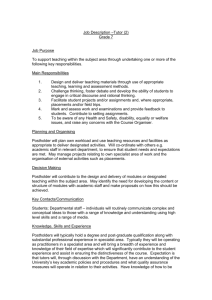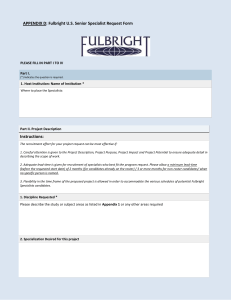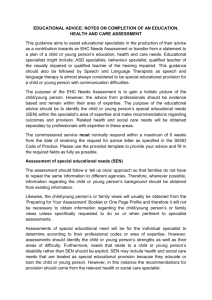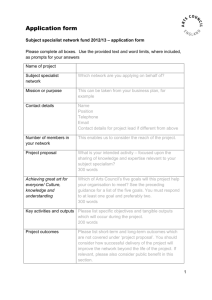Specialist Markets - Cornell University
advertisement
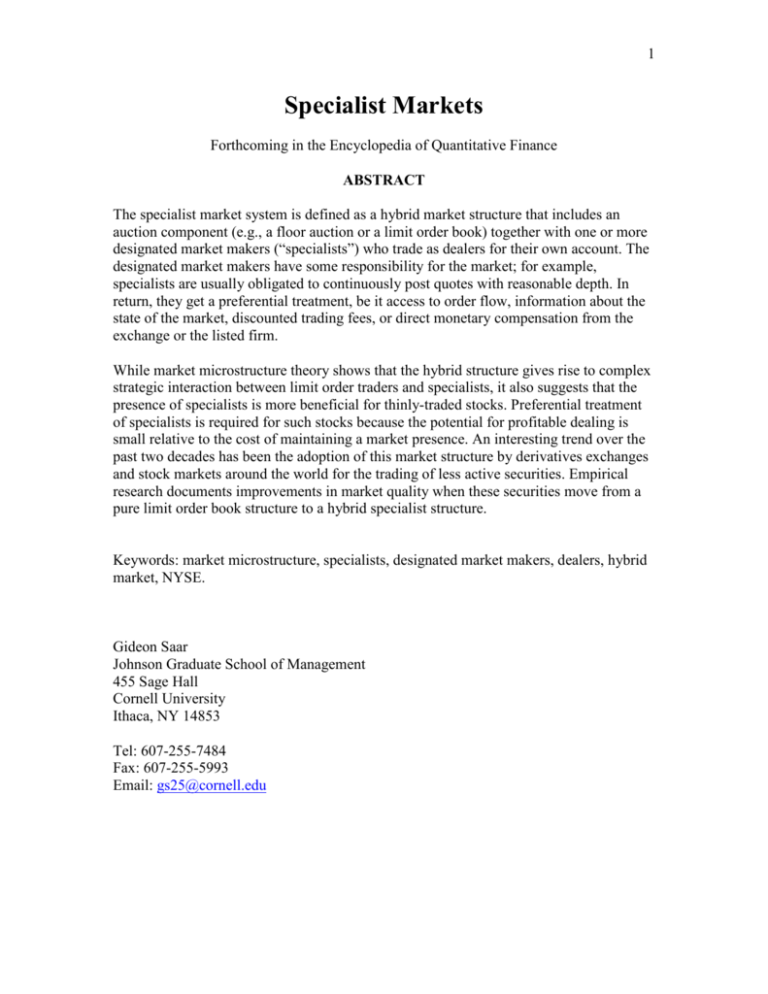
1 Specialist Markets Forthcoming in the Encyclopedia of Quantitative Finance ABSTRACT The specialist market system is defined as a hybrid market structure that includes an auction component (e.g., a floor auction or a limit order book) together with one or more designated market makers (“specialists”) who trade as dealers for their own account. The designated market makers have some responsibility for the market; for example, specialists are usually obligated to continuously post quotes with reasonable depth. In return, they get a preferential treatment, be it access to order flow, information about the state of the market, discounted trading fees, or direct monetary compensation from the exchange or the listed firm. While market microstructure theory shows that the hybrid structure gives rise to complex strategic interaction between limit order traders and specialists, it also suggests that the presence of specialists is more beneficial for thinly-traded stocks. Preferential treatment of specialists is required for such stocks because the potential for profitable dealing is small relative to the cost of maintaining a market presence. An interesting trend over the past two decades has been the adoption of this market structure by derivatives exchanges and stock markets around the world for the trading of less active securities. Empirical research documents improvements in market quality when these securities move from a pure limit order book structure to a hybrid specialist structure. Keywords: market microstructure, specialists, designated market makers, dealers, hybrid market, NYSE. Gideon Saar Johnson Graduate School of Management 455 Sage Hall Cornell University Ithaca, NY 14853 Tel: 607-255-7484 Fax: 607-255-5993 Email: gs25@cornell.edu 2 “Specialist Markets” for the trading of securities around the world are rather diverse in terms of their structural features. I begin by putting forward a general definition that attempts to capture the salient features of most specialist markets. The definition aims to be broad enough to capture both the rich history of this market structure and new variations prompted by recent technological advances. The specialist market system is defined as a hybrid market structure that includes an auction component (e.g., a floor auction or a limit order book) together with one or more designated market makers (“specialists”) who trade as dealers for their own account. The designated market makers have some responsibility for the market; for example, specialists are usually obligated to continuously post quotes with reasonable depth. In return, they get a preferential treatment, be it access to order flow, information about the state of the market, discounted trading fees, or direct monetary compensation from the exchange or the listed firm. The New York Stock Exchange (NYSE) is considered the quintessential specialist market, and one can trace several important elements in this definition to the historical development of that market. The NYSE started as an auction market, and prior to World War II the most important function of the specialist was as a brokers’ broker, coordinating the trading process and maintaining a limit order book ([20]). In other words, the auction component of the hybrid specialist system (which enables investors to trade directly with other investors) has always been a feature of this market structure, and it makes specialist markets distinct from pure dealer markets (see eqf18/016). The dealer function of the specialists on the NYSE received greater emphasis as brokers sought speedy execution of orders and the importance of the affirmative 3 obligation of specialists to assist in maintaining a fair and orderly market was stressed ([20, 21]). It is the specialist’s presence that makes this market structure different from pure auction markets (e.g., call auctions, floor markets, or limit order books; see eqf18/015 and eqf18/017). While some specialist markets mandate only one specialist, others allow (and even encourage) multiple designated market makers. On the NYSE, for example, there were competing specialists in 466 stocks when the 1933 Securities Act was passed, but their numbers decreased over the years and by 1967 no NYSE-listed securities were traded by multiple specialists (see [18], pages 337-338). As securities markets around the world face extensive competition, one of the most important questions in market microstructure is whether there is a “best” market structure for all securities that will eventually dominate the landscape. While the specialist market system was successful in the past, an interesting trend over the past two decades has been the adoption of such a market structure by derivatives exchanges and stock markets around the world for the trading of less active securities. Hence, the viability of this market structure suggests that it fulfills certain important needs of investors. In what follows, I provide a brief review of some theoretical work on specialist markets, survey recent empirical evidence on the impact of adopting a specialist system, and discuss the manner in which specialists are compensated. THEORY Much of the early literature about specialists dealt with the provision of liquidity by dealers without specific attention to whether or not they co-exist with an auction mechanism. The manner in which dealers set prices is affected by such considerations as inventory control (see eqf18/007) and information asymmetry in the market (see 4 eqf18/005). The unique hybrid structure of the specialist system, however, gives rise to additional complexity due to the strategic interaction between investors who want to use the auction component of the market (e.g., limit order traders) and the specialists. Conroy and Winkler [6] show in a simple setting that competition from public limit orders forces the specialist to offer a narrower spread. Rock [16] provides an insightful analysis of the strategic interaction between limit order traders and the specialist when some investors in the market have private information. He notes that a trader who submits a limit order to the book does not know ex ante whether his order will be executed by a small order arriving from an uninformed trader or as part of an execution of a large order coming from an informed trader. What makes the specialist on the NYSE different from other traders is the ability to condition his participation as a dealer and the prices in which he transacts on the size of the arriving market order (due to his control over the execution of trades). The presence of the specialist imposes adverse selection on the limit order traders because he takes the smaller market orders (most likely uninformed and hence profitable) and leaves the larger market orders (which are more likely to be motivated by private information) to transact against the book. Without the specialist, (uninformed) small market orders transact at worse prices because the ex ante nature of prices in the limit order book pools them together with the (informed) large market orders. The specialist’s ability to identify small market orders and offer them better prices helps small traders. Parlour and Seppi [15] use this insight to show that a hybrid market comprised of a limit order book and a specialist can coexist and even dominate a pure limit order book. The interest in this comparison stems from Glosten’s [10] claim that the electronic open 5 limit order book architecture is somehow “inevitable.” Crucial to Glosten’s results, however, are the assumptions of order flow anonymity and parity in terms of costs among liquidity providers, both of which need not hold in the case of the specialist. While the answer to whether hybrid specialist markets can compete effectively against electronic limit order books could depend on specific trading arrangements and structural features, the most recent theoretical insight is that these two markets are more similar than different. Back and Baruch [3] allow traders to “work” the orders by splitting their demand and trading it over time in smaller increments. When traders behave in this fashion, the ex post pricing power of the specialist assumed in [15], [16], and [19] no longer gives the specialist an advantage. The reason is that even if the specialist can condition on the size of the arriving market order, he does not know whether it is part of a much larger order of an informed trader that is worked over time (i.e., he cannot condition on the size of the demand underlying the order). The specialist market structure therefore does not offer any general advantage over the pure limit order book. 1 It is still possible that the presence of a specialist would be more beneficial for a certain subset of the securities in the market. Grossman and Miller [11] model risk averse liquidity provision and examine the demand for dealer services that is created by investors’ desire for immediacy of execution. They note that the specialist is far more important for the less active stocks. Profitable dealing does not arise endogenously in those stocks even in the absence of adverse selection considerations because the potential for profit is small relative to the fixed cost of maintaining a market presence (after taking 1 Glosten [9] and Leach and Madhavan [12] model the specialist as a monopolist dealer without analyzing the hybrid market interaction between the specialist and the limit order book. Both papers show that a monopolist specialist market may be robust to informational asymmetries in that it can remain open when a market populated by competitive dealers would shut down. 6 into account the risk of holding an inventory of these stocks). Sabourin [17] models the interaction of a limit order book and a designated market maker and shows that this hybrid structure offers more attractive prices than a pure limit order book for stocks with high fundamental volatility. SPECIALISTS AND MARKET QUALITY The recent introduction of designated market makers to derivatives exchanges and stock markets around the world affords us the opportunity to empirically investigate the benefits of adopting the specialist market structure. Anand and Weaver [2] show that spreads declined significantly when the Chicago Board of Options Exchange (CBOE) introduced designated market makers in 1999. On the Chicago Board of Trade, the introduction of a designated market maker to the 10-year interest rate futures contract in 2002 resulted in increased volume, reduced transaction costs, and improved price efficiency ([22]). Similarly, volume increased substantially and transaction costs declined when the Tel Aviv Stock Exchange introduced designated market makers to its thinlytraded shekel-euro options in 2004 ([8]). Several European stock exchanges implemented programs whereby less active stocks are given a choice of adding a designated market maker to accompany the auction market (usually a limit order book), effectively creating a hybrid specialist market structure. These initiatives appear to have resulted in significant improvements in market quality. For example, volume increased and spreads decreased after designated market makers were introduced on the Italian Stock Exchange ([14]). Volatility declined and liquidity improved when such programs were instituted by the Stockholm Stock 7 Exchange and Euronext ([1] and [13]). Market quality also improved for Paris Bourse stocks traded in call auctions when designated market makers were employed ([23]). The aforementioned research documented significant benefits in terms of market quality to having a specialist market structure for less actively traded stocks and derivatives contracts. A natural question is therefore how specialists can be compensated to ensure the provision of their services in these securities. THE COMPENSATION OF SPECIALISTS Specialists are expected to lose from trading with better informed investors. They also incur costs for keeping a market presence, and due to risk aversion would require an appropriate compensation for deviating from their optimal positions in risky securities. How do specialists make money? Investors’ liquidity shocks generate price reversals in the market and create profitable trading opportunities for specialists in their capacity as dealers ([11]). Beyond this mechanism, other opportunities for specialists critically depend on the rules that govern market interaction and specific devices instituted to compensate them. For example, a significant source of revenue for NYSE specialists has been fees earned from their brokerage function ([20]), but this part of their revenue has declined over the years. In some markets (e.g., the NYSE) specialists have the ability to better discern uninformed trading (if due to repeated interaction with brokers on the floor or through ex post pricing that allows conditioning on order size). 2 In addition, designated market makers in certain markets (e.g., CBOE, NYSE) enjoy privileged access to 2 See [4] for a model of how repeated interactions with floor brokers enable the specialists to offer investors better terms of trade. 8 information on the content of the limit order book, which enhances their ability to trade profitably. Another mechanism used (for example on CBOE) to ensure profitability of dealing by designated market makers is to give them pro rata share of the order flow for execution even if they only match, rather than establish, the best prices in the market. For less active securities, however, Grossman and Miller [11] suggest that it may be impossible for specialists to make sufficient money by dealing to cover their costs. Markets have offered designated market makers reduced fees (to give them a cost advantage over other traders) or direct payments (see [8]) in exchange for a commitment to make markets continuously and provide quality quotes that satisfy minimum depth and maximum spread requirements. Furthermore, if liquidity is priced (see eqf18/004), then the benefit of greater liquidity of a firm’s stock would ultimately accrue to the firm in terms of lower cost of capital. As such, the firm should be willing to pay for the services of a designated market maker. This has been the model that was recently adopted by several European stock exchanges. At the center of the market architecture of these exchanges is a transparent electronic limit order book, and therefore the designated market makers do not have ex post pricing ability, guaranteed order flow, or an informational advantage as to the content of the book. Being on the same footing as other traders who do not have an obligation to maintain continuous presence subject to minimum depth and maximum spread rules, the designated market makers can hardly be expected to make money (at least in less active stocks). Therefore, compensation arrangements include direct payments from the firm to the designated market makers, as well as indirect payments in 9 the form of future business prospects like secondary offerings, banking services, or investor relations services ([1], [13], and [23]). CONCLUSION The hybrid structure of specialist markets combines the ability of investors to trade directly with other investors in an auction setting together with the presence of designated market makers. Empirical research documents improvements in market quality when less active securities move from a pure limit order book structure to a hybrid specialist structure. Bessembinder, Hao, and Lemmon [5] claim that a designated market maker subject to a maximum spread rule can increase the allocational efficiency of prices because more investors would choose to trade when transactions costs are lower. In addition, [5] and [7] note that the informational efficiency of prices could be enhanced by the presence of a designated market maker. The reason is that obligations of the specialists to maintain price continuity or narrow spreads increase the profitability of informed trading and therefore more investors optimally choose to invest in gathering and analyzing information. As yet an unanswered question is whether the societal benefits to investors outweigh the costs of compensating the specialists. REFERENCES [1] Anand, A, Tanggaard, C, Weaver, DG. (2005) Paying for market quality. Syracuse University working paper. [2] Anand, A, Weaver, DG. (2006) The value of the specialist: Empirical evidence from CBOE. Journal of Financial Markets 9, 100-118. 10 [3] Back, K, Baruch, S. (2007) Working orders in limit-order markets and floor exchanges. Journal of Finance 62, 1589-1621. [4] Benveniste, LM, Marcus, AJ, Wilhelm, WJ. (1992) What’s special about the specialist? Journal of Financial Economics 32, 61-86. [5] Bessembinder, H, Hao, J, Lemmon, M. (2007) Why designate market makers? Affirmative obligation and market quality. University of Utah working paper. [6] Conroy, RM, Winkler, RL. (1986) Market structure: The specialist as dealer and broker. Journal of Banking and Finance 10, 21-36. [7] Dutta, PK, Madhavan, A. (1995) Price continuity rules and insider trading. Journal of Financial and Quantitative Analysis 30, 199-221. [8] Eldor, R, Hauser, S, Pilo, B, Shurki, I. (2006) The contribution of market makers to liquidity and efficiency of options trading in electronic markets. Journal of Banking and Finance 30, 2025-2040. [9] Glosten, LR. (1989) Insider trading, liquidity, and the role of the monopolist specialist. Journal of Business 62, 211-235. [10] Glosten, LR. (1994) Is the electronic open limit order book inevitable? Journal of Finance 49, 1127-1161. [11] Grossman, SJ, Miller, MH. (1988) Liquidity and market structure. Journal of Finance 43, 617-633. [12] Leach, JC, Madhavan, AN. (1993) Price experimentation and security market structure. Review of Financial Studies 6, 375-404. [13] Menkveld, AJ. (2008) Designated market makers for small-cap stocks. VU University Amsterdam working paper. 11 [14] Nimalendran, M, Petrella, G. (2003) Do ‘thinly-traded’ stocks benefit from specialist intervention? Journal of Banking and Finance 27, 1823-1854. [15] Parlour, CA, Seppi, DJ. (2003) Liquidity-based competition for order flow. Review of Financial Studies 16, 301-343. [16] Rock, K. (1990) The specialist’s order book and price anomalies. Harvard University working paper. [17] Sabourin, D. (2006) Are designated market makers necessary in centralized limit order markets? University of Paris IX Dauphine working paper. [18] Seligman, J. (2003) The Transformation of Wall Street (Third Edition); Aspen Publishers, New York, NY. [19] Seppi, DJ. (1997) Liquidity provision with limit orders and a strategic specialist. Review of Financial Studies 10, 103-150. [20] Stoll, HR. (1985) The stock exchange specialist system: An economic analysis. Monograph Series in Finance and Economics 2, Saunders, A. (ed). New York University, 1-51. [21] Stoll, HR. (1998) Reconsidering the affirmative obligation of market makers. Financial Analysts Journal 54, 72-82. [22] Tse, Y, Zabotina, T. (2004) Do designated market makers improve liquidity in openoutcry futures markets? Journal of Futures Markets 24, 479-502. [23] Venkataraman, K, Waisburd, AC. (2007) The value of the designated market maker. Journal of Financial and Quantitative Analysis 42, 735-758.

